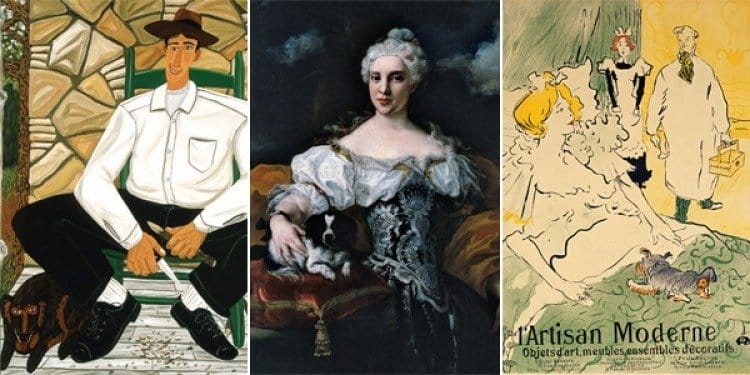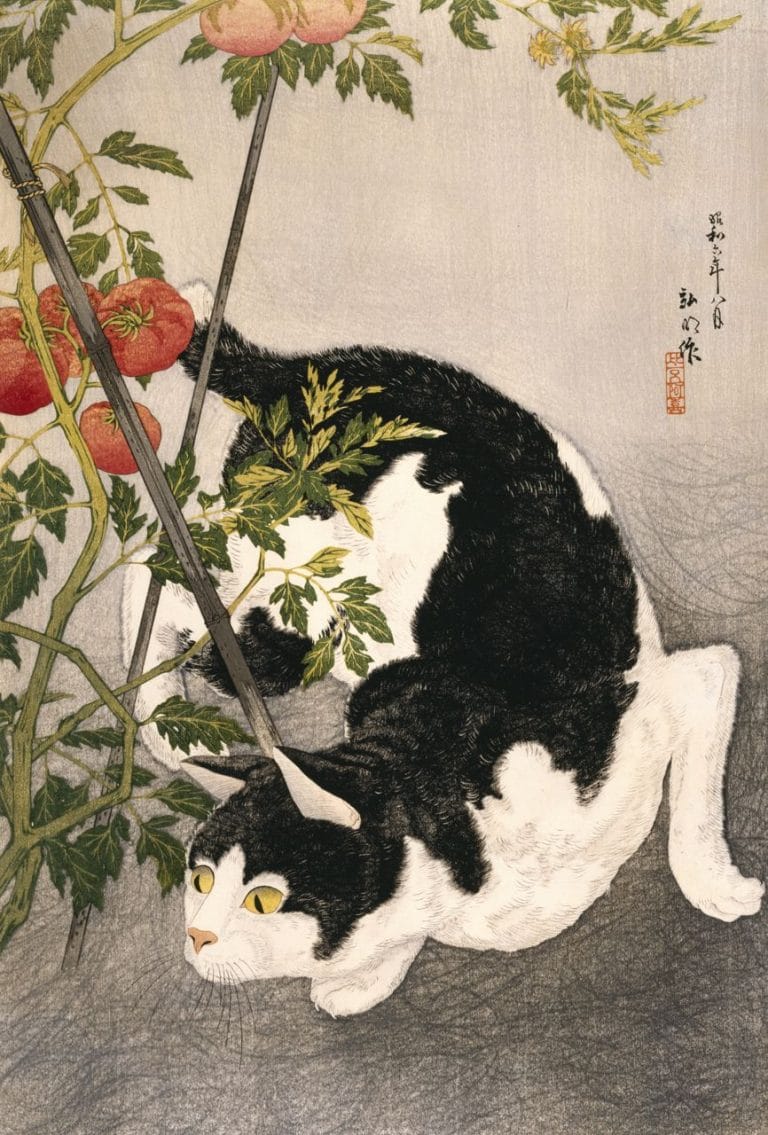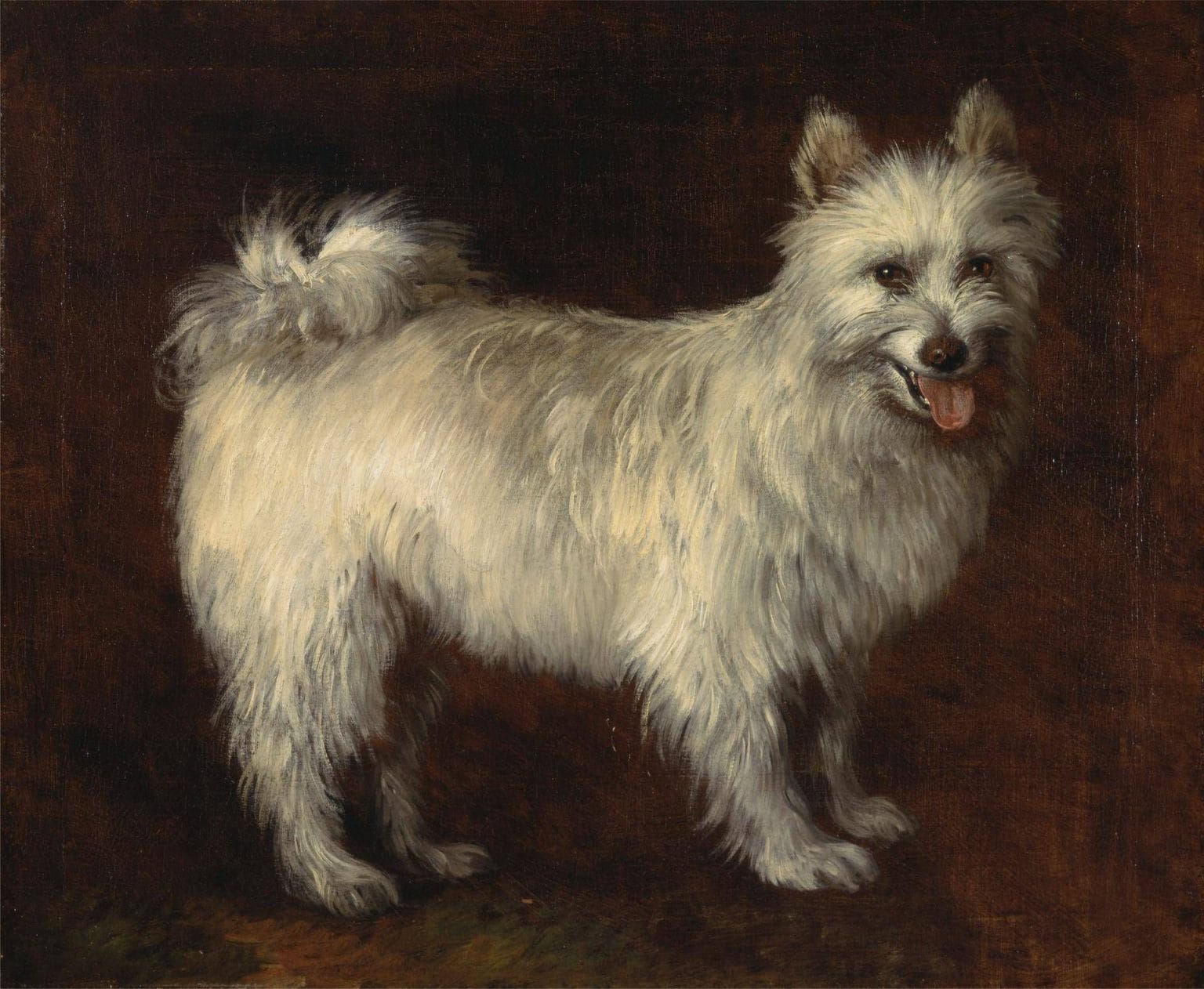Featured image: (Left) David Bates. The Whittler, 1983. Oil on canvas, 96.5 x 78.5 in. Blanton Museum of Art, Michener Acquisitions Fund, 1983.123. (Center) Marco Benefial. Portrait of a Lady with a Dog, 1730s. Oil on canvas, 45.5 x 33.875 in. Blanton Museum of Art, The Suida-Manning Collection, 41.1999. (Right) Poster for L’Artisan Moderne, 1896. Crayon brush and spatter lithograph with scraper, printed in four colors. Blanton Museum of Art, Gift of John S. and Patricia A. Corcoran, 2000.
In the Company of Cats and Dogs provides a multifaceted look at our relationship with felines and canines through the ages.
On view at the Blanton Museum of Art at The University of Texas at Austin from June 22 – September 21, 2014, the exhibition features over 150 works by masters such as Albrecht Dürer, Jean-Honoré Fragonard, William Blake, Francisco Goya, Paul Gauguin, Takahashi Hiroaki (Shotei), Pablo Picasso, Henri Cartier-Bresson, Edward Hopper, Louise Bourgeois, and others. Examining the ever-changing roles of cats and dogs and our enduring fascination with them, the presentation includes Egyptian sculpture, Chinese and pre-Columbian ceramics, medieval and Renaissance manuscripts, and prints, books, photographs, and paintings from the Blanton’s collection and those of the Amon Carter Museum of American Art; Dallas Museum of Art; the Menil Collection; Museum of Fine Arts, Houston; the San Antonio Museum of Art; Yale Center for British Art; the Harry Ransom Center at The University of Texas at Austin, and of the private collections of UT alumni and others.
“This exhibition sheds new light on a subject artists have depicted throughout history – our relationships with cats and dogs,” states Blanton Director Simone Wicha. “It provides us an opportunity to collaborate with some of the best and brightest minds on the University of Texas campus – from psychologists to historians – in a presentation that offers new research and fresh perspectives, giving us a deeper understanding of our own identities and relationships. It also gives us a chance to connect with our pet-friendly community, who will undoubtedly enjoy these dynamic portrayals of well-loved animals. In the Company of Cats and Dogs serves as a model of what a great university art museum can do.”
Drawing on research from several disciplines in the humanities and sciences, In the Company of Cats and Dogs considers some of the inherent personalities and temperaments of these animals as well as those imposed or projected by humans onto them. Throughout history, these animals have been viewed and represented as family members, hunters of prey, strays, and as figures and symbols in mythological, religious, political, and moral images. The exhibition probes these characterizations through numerous lenses, including anthrozoology (a new discipline that studies the interactions between humans and other animals) and social histories concerned with animal welfare, child development, and hunting and land rights. Francesca Consagra, the Blanton’s Senior Curator of Prints, Drawings, and European Paintings remarks, “Through especially beautiful and affecting works of art, we hope to make our visitors aware of some of the diverse and complex histories we have had with cats and dogs over a period of thirty-three centuries.”
Highlights of the exhibition include ancient Egyptian sculptures of the gods Bast and Anubis on loan from the San Antonio Museum of Art, a folio from the Tegernsee Miscellany aka Bede Compendium— an eleventh-century manuscript depicting a zodiac dog from the Harry Ransom Center, and Thomas Sully’s Cinderella at the Kitchen Fire from the Dallas Museum of Art, along with Albrecht Dürer’s St. Eustace, a group of important and rare prints by Paul Gauguin, and contemporary works by Louise Bourgeois, William Wegman and Sandy Skoglund. Also included are Blanton visitor favorites such as Marco Benefial’s Portrait of a Lady with a Dog and Arthur Fitzwilliam Tait’s Huntsman with Deer, Horse, and Rifle.
In the Company of Cats and Dogs makes connections across centuries and genres and underscores our complex relationships to these animals, revealing the many ways in which they say as much about us as we do about them.
Upcoming Programs
Second Saturdays: April 2024 – Designed for April
Anni Albers-inspired talks, live music, and more!
Program description. Lorem ipsum dolor sit amet, consectetuer adipiscing elit. Donec odio. Quisque volutpat mattis eros. Nullam malesuada erat ut turpis. Suspendisse urna nibh viverra non semper suscipit posuere a pede. Donec nec justo eget felis facilisis fermentum. Aliquam porttitor mauris sit amet orci.
Explore a wide variety of galleries & don’’’t miss these special exhibitions:
Program Schedule
6:00 – 7:30 pm
Weaving Demonstration with Zanny Cox
Join Austin-based artist Zanny Cox for an interactive weaving demonstration inspired by Anni Albers: In Thread and On Paper. In this hands-on experience, visitors will have the opportunity to contribute to a collaborative textile produced on Cox’s “community loom.” No prior weaving experience required!
About Zanny Cox: Zanny Cox is a multi-disciplinary artist based in Austin, Texas. Drawing inspiration from her Mexican, Kickapoo, and Irish ancestry, her process is inspired by ancestral knowledge and honors the voices of the past. While preserving the historical elements of handweaving and goldsmithing, her work fuses a modern aesthetic with ancient craft, crossing the boundaries of art, culture, and fashion.
Credits
In the Company of Cats and Dogs is organized by the Blanton Museum of Art.
Generous funding for the exhibition is provided by Dana and Gene Powell, with additional support from Leslie and Jack Blanton, Jr., the Carl and Marilynn Thoma Foundation, Cornelia and Meredith Long, Alessandra Manning-Dolnier and Kurt Dolnier, Susan and Richard Marcus, the Scurlock Foundation Exhibition Endowment, and a grant from Humanities Texas, the state affiliate of the National Endowment for the Humanities.



